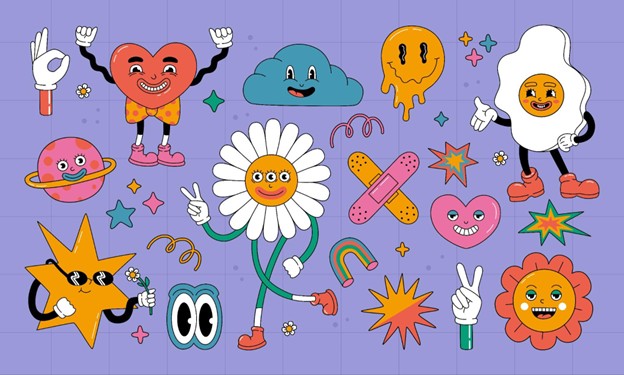6 Advanced Tips on Using Vector Graphics in Designs
Recently, vector graphics have become one of the key elements of modern design. They offer versatility, clarity, and efficiency, making them a popular choice for professional design projects. Whether you’re a seasoned designer or are just starting out in the creative industry, understanding what a vector graphic is and how to use it effectively in your work is beneficial.
This article explores key stock vector benefits and shares advanced tips for leveraging stock vector images to craft exceptional designs. Read on to learn more!

What is a stock vector graphic?
Vector graphics meaning revolves around the use of geometric shapes, lines, and curves to represent images. Unlike raster images, which are made of pixels, vector graphics are created using paths based on mathematical equations. These paths are scalable without losing quality—you can resize them to any dimension without them getting pixelated or blurry.
Stock vector images, in particular, are pre-designed graphics ready to be used in your projects. They can be customized, combined, and adapted to fit the specific needs of your work. If you browse Depositphotos stock vectors, you will find a vast selection of high-quality, royalty-free illustrations suitable for numerous creative applications, from logos and branding materials to infographics and icons.
Key benefits of stock vector images
There are several reasons why stock vector graphics are integral to modern design workflows. Here are the key benefits:
- Infinite scalability without quality loss. Whether you’re designing a logo for a business card or a large billboard, vector image files maintain their crispness and clarity at any size. You don’t need to worry about resolution or pixelation, even when working with large-format designs.
- Time and cost efficiency. Stock vectors can save your time and money, as instead of creating complex graphics from scratch, you can access high-quality pre-designed elements online offered at affordable prices.
- Flexibility and customization. Stock vector images offer exceptional flexibility with customizable colors, shapes, and other design elements. You can easily match your web, logo, or print project’s requirements by adjusting these elements to fit your brand’s style, theme, or specific vision.
- Consistency across platforms. With vector scalability, your design will maintain sharpness and uniformity on websites, mobile apps, and printed materials, preserving your brand identity across all mediums.
- Access to professional-quality designs. Stock vector images are often uploaded to online content marketplaces by seasoned creators, ensuring you have access to high-quality, unique graphics that meet professional standards for your projects.

6 advanced tips to effectively use stock vector graphics in your designs
1. Combine multiple stock vectors to create unique designs
Settling for a single vector element is limiting. Combine different stock vector images and elements to create a design that’s entirely your own and has a unique character. By merging different vectors, you can produce exclusive compositions that cater to your creative vision. To achieve this, consider the following techniques:
- Select complementary elements from various vector sets;
- Master layering, transforming, and blending techniques;
- Harmonize color palettes for cohesive compositions;
- Adjust opacity and blend modes for seamless integration;
- Scale and rotate elements to create dynamic layouts;
- Experiment with overlapping shapes for depth and texture.
2. Master the art of customization for branding
Customization is essential for creating a design that reflects your unique brand identity and sets you apart. Whether you’re adjusting colors, adding text, or changing proportions, tailoring vector graphics to align with your branding is key to maintaining a cohesive look. This is particularly important when you’re working with graphic vector design elements, as customizing them ensures they fit seamlessly into your brand identity and consistent design. And companies report that branding consistency adds 10% more to the 20% of their growth.
3. Use vectors for complex illustrations in infographics
Infographics are a go-to tool for conveying information engagingly. And vector graphics are ideal for this purpose—they allow you to create clean and clear illustrations that are easily read and visually appealing. You can use stock vector images to build complex charts, icons, and other elements that make your infographics informative and attractive. For example, incorporate vector icons to represent data points, use vector shapes to organize information into sections, or apply custom colors to enhance readability and visual flow.

4. Optimize vectors for different mediums
Adaptability is one of vector graphics’ strengths. When using them in designs, it’s important to optimize them for the intended medium. For example:
- Adjust the resolution and color modes(CMYK) to ensure high-quality reproduction;
- Digital screens. Optimize the file size and format for faster loading times while maintaining sharp visuals (RGB color mode);
- Social media. Modify aspect ratios and visual elements to fit various platform requirements and create eye-catching designs that perform well in feeds. For example, for Instagram, use a square 1080x1080px image; for Facebook, opt for 1200x628px for shared posts; and for LinkedIn, a 1200x627px image works best for professional visibility.
This ensures your design looks great everywhere it appears.
5. Incorporate subtle texture or gradients
To add depth and interest to your creative work, incorporate subtle textures or gradients into your graphic vector designs. This can elevate a flat design and make it more visually compelling. Be mindful to keep it balanced, as overuse can detract from the clarity of the vector design.
Consider the following techniques:
- Layer translucent textures for nuanced depth;
- Use noise filters for organic surface variations;
- Blend multiple gradients for complex color transitions;
- Implement clipping masks to constrain textures;
- Experiment with opacity for delicate overlays;
- Combine vector and raster textures for unique effects;
- Apply grain overlays for subtle dimension;
- Create custom brushes for textured strokes.
6. Leverage vector animations for immersive digital designs
Vector graphics are great for animation due to their scalability and clarity. For websites, apps, social media posts, and other digital mediums, vector animations can make your designs interactive, immersive, and visually exciting.
Master vector animation with these quick tips:
- Leverage Adobe After Effects or CSS for web animations;
- Create subtle, purposeful motion to avoid overwhelming users;
- Optimize file sizes for smooth cross-device performance;
- Align animations with brand personality;
- Use strategic keyframes for fluid transitions;
- Experiment with morphing shapes for eye-catching effects;
- Implement responsive animations for various screen sizes;
- Combine vector animations with interactive elements for enhanced user experience.
Conclusion
Incorporating vector graphics into designs opens up a well of creative possibilities. Their scalability, flexibility, and professional quality make them perfect for designers looking to create appealing, customizable, immersive visuals. By understanding and leveraging the benefits of stock vector images, you can efficiently produce high-quality designs for any medium. Use this article’s advanced tips to master the art of graphic vector design and push the boundaries of your creativity.

Amanda Dudley is a lecturer and writer with a Ph.D. in History from Stanford University. After earning her doctorate in 2001, she decided to pursue a fulfilling career in the educational sector. So far, she has made giant strides by working as an essay writer for EssayUSA, where she delivers high-quality academic papers to students who need them.






